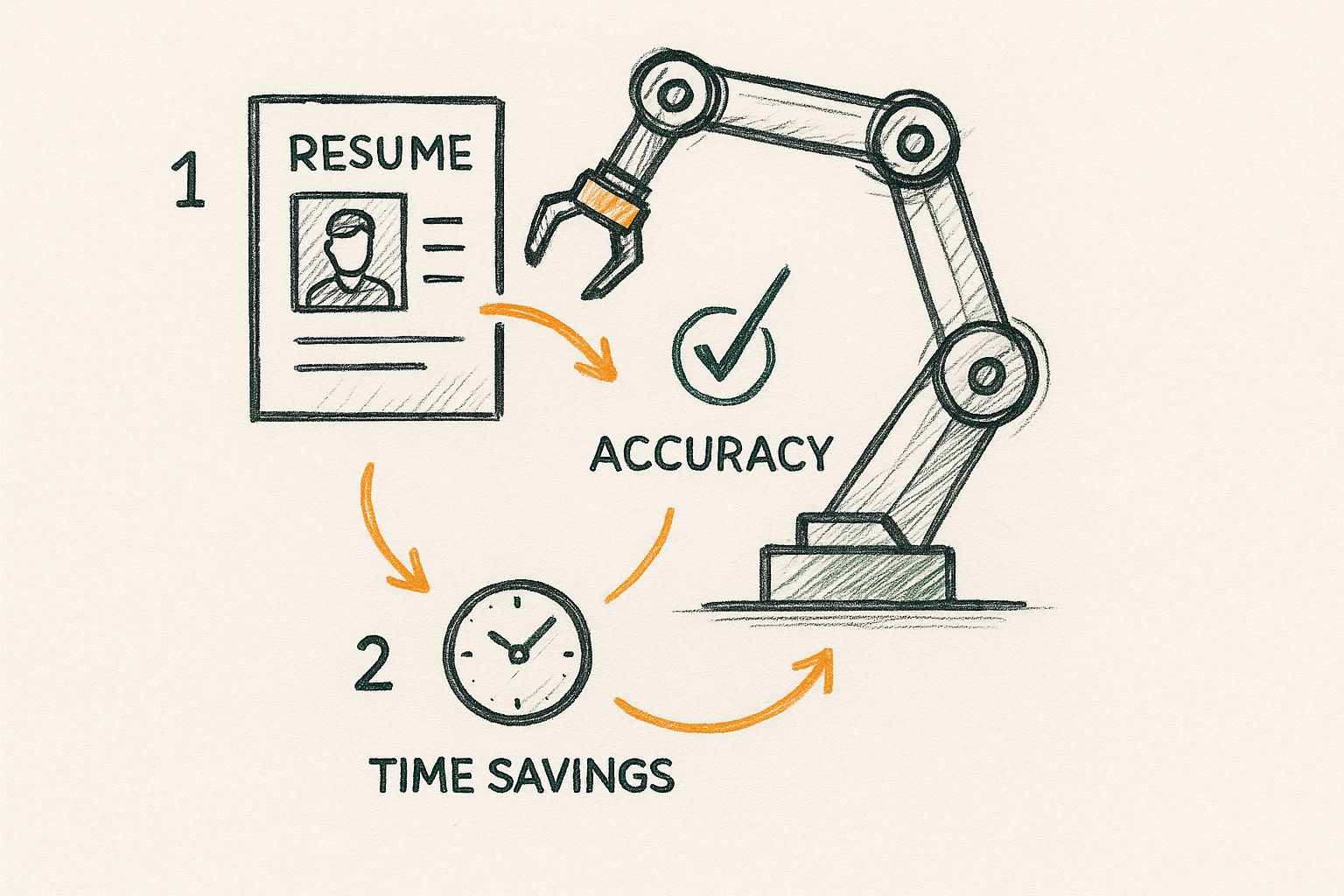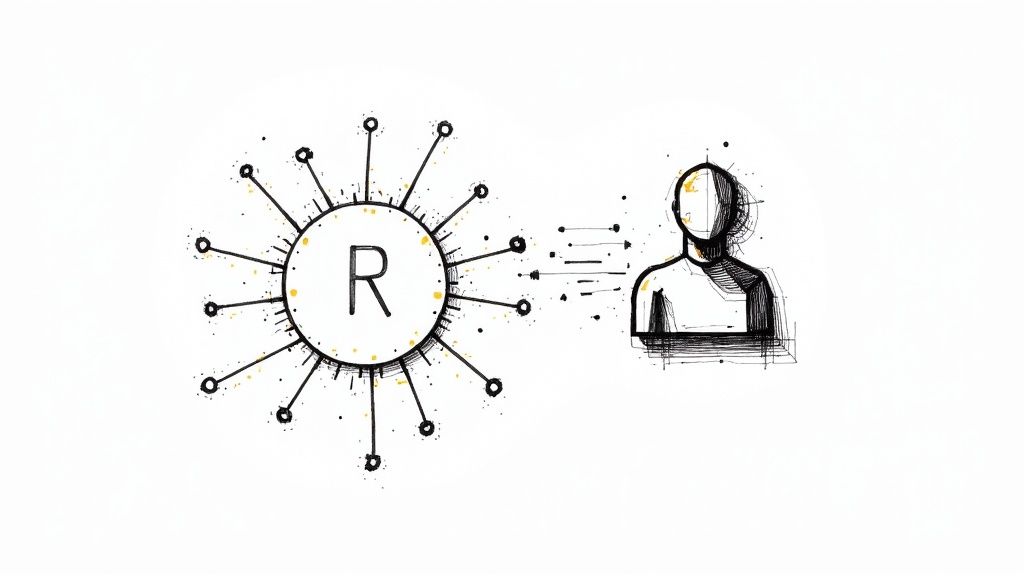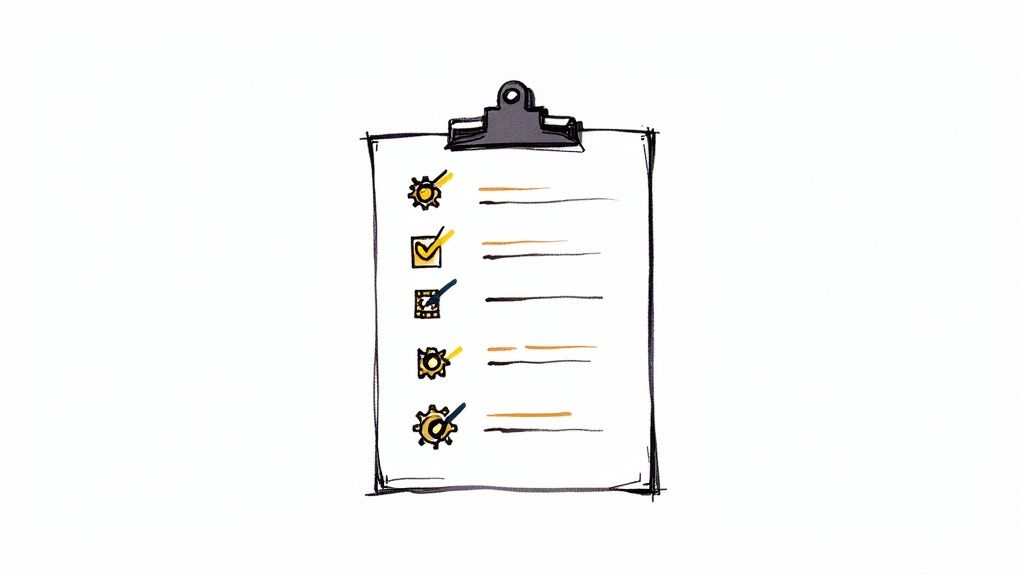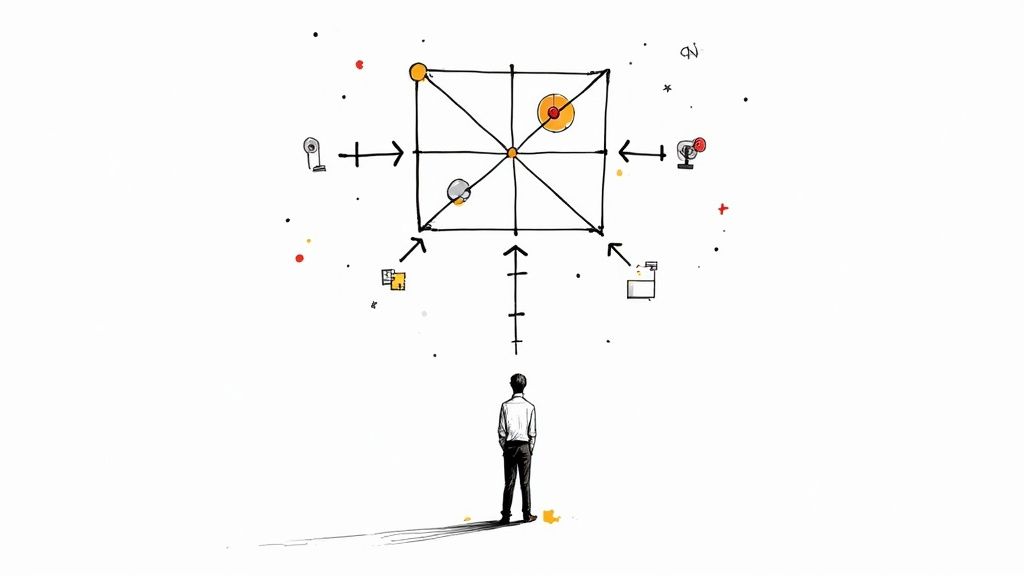Think about the last time you posted a job opening. How long did it take for the applications to start flooding in? For most popular roles, recruiters are buried under a digital mountain of resumes, and sifting through them one by one is a monumental task. It’s slow, tedious, and frankly, a recipe for burnout.
That’s where automated candidate screening comes in. It’s not about replacing recruiters with robots; it’s about giving them a powerful assistant. This technology uses tools like artificial intelligence to do the heavy lifting—reviewing, sorting, and ranking applications so your team can jump straight to the most promising people.
What Is Automated Candidate Screening Anyway?
Let’s stick with that mountain of resumes. Trying to manually screen every single one is like trying to find a needle in a haystack with your bare hands. You might find it eventually, but it’s going to take a long time, and you’ll probably get pricked a few times along the way.
Automated screening is like handing your team a powerful magnet that pulls the needles right to the surface. It instantly highlights the candidates who have the skills and experience you’re looking for.
And we've come a long way from the early days of automation. The first systems were pretty basic, mostly just scanning for specific keywords. If a resume didn't have the exact term "Project Manager," it was tossed aside, even if the person had all the right experience.
Today’s platforms are much smarter. They use AI and machine learning to understand context and nuance. They know that skills like "Agile methodologies," "Scrum Master," or "product roadmap development" are highly relevant for a project management role, even if the exact job title is missing. It’s a much more intelligent way to find talent.
The Shift from Manual to Automated
The move to automation is happening for a simple reason: the old way is broken. No matter how dedicated your recruiters are, they’re still human. They get tired, they have only so many hours in a day, and they’re susceptible to unconscious bias. An automated system, on the other hand, can screen thousands of resumes with the same objective criteria every single time.
This frees up your talent acquisition team to do what they do best—connect with people.
Instead of getting bogged down in administrative quicksand, they can focus their energy on high-impact activities like:
- Engaging with top-tier, pre-vetted candidates.
- Building genuine relationships and getting people excited about your company.
- Conducting thoughtful interviews to really dig into cultural fit and soft skills.
- Creating smart sourcing strategies for those really tough-to-fill positions.
This shift turns recruiters from processors into strategists. It allows them to stop searching for qualified people and start connecting with them.
For a clearer picture, let's break down the key differences between the old and new ways of working.
Manual vs. Automated Screening At a Glance
The table below offers a quick comparison, highlighting how automation changes the game in terms of efficiency, consistency, and the ability to scale your hiring efforts.
| Aspect | Manual Screening | Automated Screening |
|---|---|---|
| Speed | Slow; can take days or weeks to review all applications. | Extremely fast; processes thousands of applications in minutes. |
| Efficiency | Low; requires significant human hours for initial review. | High; frees up recruiters for strategic, high-value tasks. |
| Consistency | Varies; subject to human error, fatigue, and unconscious bias. | Highly consistent; applies the same objective criteria to every resume. |
| Scalability | Poor; struggles to handle high volumes of applicants effectively. | Excellent; easily scales to manage any number of applications without a drop in quality. |
| Candidate Experience | Often slow, leading to long wait times and candidate drop-off. | Can be faster and more responsive, keeping top candidates engaged. |
| Focus | Administrative; centered on sorting and filtering large volumes of data. | Strategic; centered on engagement, relationship-building, and assessment. |
As you can see, the contrast is stark. Automation doesn't just make the process faster—it fundamentally changes the nature of a recruiter's job for the better.
The adoption of these tools isn't just a niche trend; it's rapidly becoming the industry standard. It's predicted that by 2025, AI will handle around 95% of initial candidate screening. In fact, 87% of companies are already using AI-powered software to improve their hiring.
You can dive deeper into these recruiting statistics and their impact on modern hiring at TalentMSH. The takeaway is clear: this isn’t a passing fad. It’s the new foundation for effective, scalable, and human-focused recruiting.
How Automated Screening Systems Actually Work
To really get what's happening with automated candidate screening, you have to look under the hood at the engine that drives it all: the Applicant Tracking System (ATS). The best way to think about an ATS is like a hyper-organized digital filing cabinet for your entire talent pool. But it’s not just storing resumes. It’s actively reading, understanding, and sorting every single one so you can pinpoint the right person when you need them.
This isn't just a fancy keyword search, either. When a candidate uploads their resume, the ATS kicks off a whole process designed to translate that document—a mess of unstructured information—into clean, structured data a recruiter can actually use.
The whole point, from the moment a resume is submitted to when a recruiter finally sees it, is to bring a dose of efficiency and order to the chaotic top of the hiring funnel. This image breaks down how an ATS can scan and process a resume in seconds.

As you can see, the system is all about turning that raw text into tidy data points. These can then be measured against what the job actually requires, dramatically cutting down that initial review time.
The Parsing and Extraction Phase
The very first, and maybe most important, step is resume parsing. This is where the ATS software "reads" the resume file—whether it's a PDF, Word doc, or something else—and breaks it down into its core pieces. It’s looking for and pulling out key bits of information like:
- Contact Information: Name, email, phone number, and location.
- Work Experience: Company names, job titles, and employment dates.
- Education: Degrees, schools, and graduation dates.
- Skills: Specific hard skills like "Python," "Salesforce," or "AutoCAD," along with any relevant soft skills it can identify.
Once extracted, this information gets plugged into a standardized candidate profile. Now, every single applicant is presented in the same uniform format, which makes it infinitely easier for recruiters to compare people fairly, apple to apple.
The Matching and Scoring Algorithm
With all that data neatly organized, the real work of automated screening kicks in. The ATS starts comparing the candidate's profile against the specific requirements you’ve set for the role. And this is where modern systems have gotten pretty smart; it’s not just a simple keyword checklist anymore.
A well-configured system can look for things like:
- Mandatory Qualifications: These are the deal-breakers—a specific license, a minimum number of years of experience, or the legal right to work in the country. If a candidate is missing one of these, they're often filtered out automatically.
- Preferred Skills: These are the "nice-to-haves" that make someone a stronger fit. The system can even assign points for each preferred skill it finds, helping to rank candidates.
- Contextual Relevance: This is where it gets clever. An advanced ATS can understand that "PMP certification" and "Project Management Professional" mean the same thing. It can also group related skills, like knowing that experience with "Hootsuite" and "Sprout Social" both fall under the umbrella of social media management.
Based on all this, the ATS usually spits out a match score for every applicant. This gives recruiters a prioritized list, letting them focus their precious time on the people who look best on paper, right from the start.
The goal of an automated screening system is not to make hiring decisions. It is to present human recruiters with a highly qualified, pre-vetted shortlist, enabling them to make better, faster, and more informed choices.
The Risk of Poor Configuration
The power of these systems is obvious, but it comes with a huge warning label. If an ATS is set up poorly, it can cause more problems than it solves. And with 99% of Fortune 500 companies using an ATS, this isn't a small-scale issue.
The problem? A shocking 88% of employers admit they believe qualified candidates are getting filtered out simply because their resumes aren't perfectly formatted for the machine. This leads to a brutal reality where around 70% of resumes are rejected before a human ever lays eyes on them. You can dig deeper into these numbers and what they mean for hiring over at SelectSoftware Reviews.
This just goes to show how critical it is to be thoughtful when you set up your screening rules. If your criteria are too rigid—like demanding an exact keyword or a specific resume layout—you're going to accidentally disqualify fantastic people. The trick is to strike a balance between automation and human judgment, making sure the tech is your guide, not a gatekeeper.
The Real-World Benefits of Automating Your Hiring
So, we've talked about the tech and the algorithms, but what does automated candidate screening really do for your organization? Let's get down to brass tacks. The impact isn't just about shaving a few hours off your process; it’s about fundamentally changing your hiring outcomes for the better. These benefits ripple out across the entire recruitment funnel, influencing everything from how fast you can fill a role to the quality and diversity of the teams you build.
Forget the theory for a minute. Let’s look at the three core benefits that truly change the game: speed, quality, and fairness. These aren't just empty buzzwords. They are tangible, measurable improvements that tackle the biggest headaches in modern talent acquisition.

Accelerate Your Time to Hire
In today's market, speed is non-negotiable. The best candidates? They're often off the market in just 10 days. If your team is stuck manually sifting through hundreds of resumes for a single opening, you're not just moving slowly—you're losing the race before you even leave the starting line. This is where automation delivers its most immediate, dramatic payoff.
Picture the traditional process: a recruiter painstakingly opens, reads, and assesses every single application. That initial screening phase is a massive bottleneck, eating up countless hours. Automated candidate screening absolutely demolishes it. The software can chew through thousands of applications in the time it takes a person to get through a small stack, instantly generating a shortlist of qualified people.
This has a massive chain reaction:
- Faster Shortlisting: Your recruiters can start engaging with top talent within hours of their application, not days or weeks later.
- Reduced Candidate Drop-Off: A fast, responsive process keeps top performers interested and prevents them from accepting a competing offer while they wait to hear from you.
- Increased Recruiter Productivity: By automating the most mind-numbing task, you free up your team to focus on the human side of hiring—like building relationships, interviewing, and closing great candidates.
A Deloitte study found that companies using this kind of automation slashed their hiring time by as much as 75%. This isn't just a minor convenience; it's a massive competitive advantage.
Enhance the Quality of Your Hires
Hiring faster is fantastic, but it's pointless if you aren't bringing the right people into the fold. This is where automated screening evolves from a simple time-saver into a powerful strategic tool. It uses data-driven analysis to spot top-tier talent that a human reviewer, with all their inherent biases, might completely miss.
A human recruiter, no matter how skilled, might unconsciously gravitate toward candidates with familiar career paths or from specific industries. But an AI-powered system can be set up to hunt for transferable skills and core competencies.
For example, a candidate from a healthcare background might have phenomenal data analysis skills that would be perfect for a fintech role. A human reviewer laser-focused on finding financial experience might skim right past them. The intelligent system, however, flags those crucial skills and presents this "hidden gem" for review.
Automation improves hire quality not by replacing human judgment, but by enriching it. It provides objective, data-backed insights, allowing recruiters to make more informed decisions based on a candidate's true potential.
Unilever famously used AI to analyze video interviews and discovered that their hiring managers were 50% more satisfied with the quality of the candidates they hired. It's proof that when you base decisions on skills and potential, you build stronger, more capable teams. These kinds of wins aren't just limited to hiring; understanding the broader key business process automation benefits shows how much efficiency you can unlock across an entire company.
Promote Fairness and Reduce Bias
Unconscious bias is one of the toughest, most persistent challenges in recruiting. Even the most well-intentioned hiring managers can be subtly influenced by factors like a candidate's name, gender, age, or where they went to school. These biases can lead to homogenous teams and, worse, cause you to miss out on incredible people.
Automated screening acts as a powerful counterbalance. By zeroing in only on objective, predefined criteria—like skills, specific experiences, and qualifications—it standardizes the entire initial review. Every single candidate is measured with the exact same yardstick.
This systematic approach is a huge boost for diversity and inclusion efforts by:
- Anonymizing Early Stages: Many systems can be configured to hide demographic information during the initial screen, removing it from the equation.
- Ensuring Consistency: The same rules get applied to every resume that comes in, which gets rid of human subjectivity.
- Focusing on Merit: The system prioritizes what a candidate can do over who they are.
This creates a much more equitable playing field where every applicant gets a fair shot based on their actual abilities. As you modernize your hiring, other tools like on-demand asynchronous interviews can further standardize the process, helping you build a more diverse and talented workforce. When you systematically reduce bias, you're not just checking a compliance box—you're opening the door to a richer, more innovative talent pool.
Using AI for Smarter Candidate Matching
If your standard automated screening is like giving recruiters a handy digital assistant, think of AI as upgrading them to a full-fledged data scientist. It’s a move beyond basic filtering and keyword hunting. AI injects a layer of intelligence that turns screening from a simple sorting task into a genuinely strategic matching process.
A traditional Applicant Tracking System (ATS) is a bit like a calculator—it’s fantastic at following the specific rules you program into it. AI, on the other hand, is more like a powerful financial modeling platform. It doesn’t just follow the rules; it learns from data, understands context, and makes predictions. This leap in capability helps you find candidates who don’t just tick the boxes on a job description, but are actually poised to thrive in your company.
Moving Beyond Keywords with Semantic Analysis
One of the biggest headaches with older screening systems is their blind reliance on exact keywords. AI-powered tools sidestep this problem with semantic analysis, which is just a fancy way of saying the system gets the meaning and context behind words, not just the words themselves.
This is a complete game-changer. An AI tool understands that a “growth marketer” and a “demand generation specialist” are essentially cousins, sharing many of the same core skills. It knows that experience in “client relationship management” is incredibly relevant for an “account management” role, even if the resume uses different phrasing.
By picking up on these subtleties, AI starts to uncover hidden gems in your talent pool—people with highly transferable skills who would have been completely missed by a rigid, keyword-based system. Suddenly, your pool of qualified candidates gets deeper, and you start seeing great talent from industries you never would have considered.
Predicting Success with Advanced Analytics
The really powerful automated screening platforms use AI for more than just matching past experience. They use predictive analytics to forecast a candidate’s potential for future success at your company. The system digs into the data of your current top performers to find the common threads—the skills, career paths, and even the soft skills that correlate with success.
AI-driven screening doesn't just ask, "Does this person have the skills for this job?" It asks, "Does this person have the same attributes as our most successful people?" This shifts the entire focus from just filling a role to building a high-potential team.
This predictive power helps you assemble stronger, more resilient teams. For instance, the AI might flag that candidates who successfully moved between different roles in their past companies tend to be highly adaptable—a quality that’s tough to screen for manually but is priceless for long-term growth. It’s a smarter way to build a workforce that will grow with you.
Aligning Candidates with Culture and Growth Potential
Smarter matching isn't just about hard skills, either. The best AI tools can help you gauge alignment with your company culture and spot people with a high ceiling for growth. By analyzing the language in resumes or screening question responses, the AI can look for indicators of collaboration, leadership, or an innovative mindset.
This helps you find people who won't just crush it in their specific role but will also be a positive force for the entire team. You're looking for a holistic fit, not just a set of skills.
The results speak for themselves. An incredible 98% of hiring managers report major process improvements after bringing AI into the mix. Digging deeper, 74% believe it helps them accurately assess if an applicant is a good fit for a role, and 73% love that it can match candidates to other open positions in the company, not just the one they applied for. You can see more on these findings in Insight Global's comprehensive report.
This isn’t just hype. AI is fundamentally reshaping recruitment into a core strategic advantage, moving it far beyond simple automation. By using AI for smarter candidate matching, you're not just filling seats faster. You're building a more capable, aligned, and future-proof workforce.
Implementing Automated Screening The Right Way
Bringing automated candidate screening into your hiring process is a lot more than just flipping a switch on some new software. If you want to get all the benefits without hitting the usual speed bumps, you need a thoughtful, human-first strategy. Think of it like getting a powerful new tool for your workshop—its real value comes down to how you set it up, use it, and keep it tuned up.
This isn't just a tech project. It's a strategic move that needs clear goals, your team's support, and a solid commitment to fairness. The whole point is to give your recruiters better info and more time, not to build a system that accidentally filters out fantastic people. Success comes from treating automation like a helpful assistant, not a replacement for human judgment.

Define Your Objective Screening Criteria
Before a single resume gets scanned, your team needs to agree on what "good" actually looks like for every open role. Honestly, this is the most critical step. If your criteria are vague or biased, you're just automating a flawed process, making it faster but not better.
Get your hiring managers and recruiters in a room and hash out a concrete list of qualifications. The key is to split them into two distinct buckets:
- Must-Haves: These are the absolute, non-negotiable requirements. Think of a specific license (like a CPA for an accountant), a necessary certification, or the legal right to work in the country. If a candidate doesn't have these, they simply can't do the job.
- Nice-to-Haves: These are the skills and experiences that make someone a stronger candidate but aren't deal-breakers. Your system can award points for these, helping you rank applicants without knocking them out of the running prematurely.
By setting these ground rules from the start, you're building your automated system on a foundation of objective, job-relevant standards. That clarity is everything.
Train Your Team For Success
New tools change old workflows. It's vital to train your recruiters on more than just how to click the right buttons. They need to understand the why behind the tech to truly embrace it.
Your training should hit these key points:
- Understanding the "Why": Show them how the tool frees them from tedious admin work so they can focus on what they do best—engaging with great candidates and thinking strategically.
- Interpreting the Results: Teach them to see the system's output (like match scores or flagged keywords) as a starting point for their own expert evaluation, not the final word.
- The Human-in-the-Loop: Reinforce that their expertise is irreplaceable. Their job is to review the system's suggestions, spot potential false negatives, and make the ultimate decision.
When your team is well-trained, they see automation as a partner. It’s a tool that hands them data and insights, empowering them to make smarter, more informed choices while they stay firmly in the driver's seat.
Audit The System And Maintain Fairness
An automated system is only as good—and as unbiased—as the rules you give it. This is not a "set it and forget it" deal. You have to regularly check in on your automated screening process to make sure it's working as intended and not accidentally creating systemic bias.
Set a schedule for regular audits, maybe once a quarter, to dig into the data. What are the pass/fail rates for candidates from different backgrounds? Are any strange patterns popping up? For example, if your system seems to consistently penalize candidates with non-traditional career paths, your criteria might be too rigid.
This cycle of continuous improvement is what keeps your tool sharp, effective, and aligned with your goal of hiring equitably.
Keep The Candidate Experience Human
Finally, never forget there's a real person behind every single application. Automation should make your process better for candidates, not colder. When used correctly, it can actually improve the experience by providing faster, more consistent communication.
Here are a few ways to keep the human touch front and center:
- Automate Acknowledgements: Instantly send a confirmation email when an application comes in. It’s a small thing, but it reassures candidates their resume didn't just vanish into a digital void.
- Provide Clear Updates: If a candidate isn't moving forward after the initial screen, use automated emails to let them know with respect. Leaving people hanging is a surefire way to damage your employer brand.
- Personalize Later Stages: As candidates progress, the communication needs to become more personal. Automation does the heavy lifting at the top of the funnel, freeing up your recruiters to build genuine connections with your most promising applicants.
Modern hiring tech offers many ways to enhance this experience. For instance, you can learn more about smart hiring with one-way and on-demand asynchronous interviews to see how other tools can help you maintain a great candidate journey.
How to Choose the Right Screening Software
Walking into the buzzing marketplace of recruitment tech can feel like a lot. Every platform promises to solve all your hiring headaches, so how do you cut through the noise and find the one that’s actually right for your team? The secret isn't about getting dazzled by flashy features. It's about getting back to basics and focusing on your real, practical needs.
Think of it like a master carpenter picking out a new saw. They don't just grab the most expensive one on the shelf. They choose the one that fits their hand, works with their existing tools, and is built for the specific kind of work they do day-in and day-out. Your goal is the same: find a platform that fits your workflow, your team, and your company's ambitions.
Evaluate Your Current Tech Stack
Before you even book a single demo, take a look inward. Do a quick audit of the HR tech you’re already using. Why? Because the most powerful software on the planet is worthless if it doesn’t play nicely with your current setup. A clunky, disconnected process just creates more manual work, defeating the whole purpose.
Ask yourself these critical questions:
- Applicant Tracking System (ATS): How well does the screening software integrate with your ATS? A native or well-designed integration means data flows automatically, saving you from the soul-crushing task of manual data entry.
- Communication Tools: Does it hook into your team's chat tools, like Slack or Microsoft Teams? Getting real-time notifications right where your team lives keeps everyone in the loop and ready to act.
- Scheduling and Calendars: Can it sync up with Google Calendar or Outlook? This is a must-have for automating interview scheduling and sidestepping those frustrating back-and-forth emails.
A system that plugs in seamlessly becomes a natural part of your workflow, not just another tab you have to keep open. For genuine efficiency, this is completely non-negotiable.
Assess Scalability and Future Growth
The tool that solves your problems today needs to be ready for your challenges tomorrow. As your company scales, so will your hiring volume. You need a platform that can handle a bigger load without buckling under the pressure—or blowing up your budget.
Look at scalability from a few different angles:
- Volume: Can the system comfortably handle hundreds, or even thousands, of applications without slowing down?
- Users: How easy and affordable is it to add more recruiters and hiring managers as your team grows?
- Features: Can you start with a basic plan now and unlock more advanced tools later, like AI-powered video analysis or predictive analytics, as your needs get more sophisticated?
Picking a scalable solution now saves you from the massive headache and expense of ripping out and replacing a system a few years down the line.
Prioritize Usability and User Experience
Let's be honest: if a tool is a pain to use, your team just won't use it. User-friendliness isn't some fluffy "nice-to-have" feature; it's absolutely critical for getting your team on board and seeing a return on your investment. The platform needs to feel intuitive for everyone—recruiters, hiring managers, and especially the candidates.
A great user experience ensures that technology empowers your team rather than frustrating them. It should simplify tasks, provide clear insights, and make the hiring process feel more organized and less chaotic for everyone involved.
When you're looking at different platforms, insist on running a small pilot. Let a couple of your recruiters use it for a real, live job opening. This is the ultimate test to get honest feedback on how easy it is to navigate. While you're at it, think about how you'll capture that feedback. You can learn how to create an effective interview evaluation form to give this process structure and make your final decision that much clearer. A smart investment today will pay off for years.
Got Questions About Automated Screening? We’ve Got Answers.
Even with all the benefits laid out, it’s natural to have a few questions lingering in the back of your mind. Let’s tackle some of the most common ones that pop up when hiring teams start thinking about bringing automation into their process.
Does Automation Take the Human Out of Human Resources?
Not in the slightest. The best way to think about an automated screener is as a super-efficient research assistant, not the hiring manager. Its real job is to take on the most repetitive, mind-numbing part of recruiting—that initial pile of resumes.
This frees up your recruiters to do what they’re truly great at: building relationships with promising candidates, gauging who will genuinely thrive in your company culture, and making those final, nuanced judgment calls. The big decisions? Those always stay in human hands.
Is This Technology Really Unbiased?
Here’s the honest answer: This tech has the potential to be far less biased than a human-led process. By sticking to objective, pre-set criteria, it can sidestep the unconscious biases we all carry.
But it’s not magic. An automated system is only as fair as the rules you give it. If you want to build a truly equitable hiring process, you have to be diligent. That means regularly auditing your system, refining your screening rules to sniff out any hidden biases, and always, always keeping a human in the loop for the final say.
How Can I Optimize a Resume for These Systems?
If you're a candidate, you want to make it as easy as possible for the system to see you're a great fit. The key is clarity and relevance.
- Keep it clean: Stick to standard, easy-to-scan formatting. Avoid fancy columns, graphics, or unusual fonts that can confuse the software.
- Speak their language: Carefully read the job description and mirror its language. Weave in the specific keywords and skills the posting mentions. This isn’t about tricking the system; it’s about helping it make an accurate match between your qualifications and the role’s needs.
What’s the Difference Between an ATS and an AI Screener?
This is a great question, and the distinction is important.
Think of an Applicant Tracking System (ATS) as a digital filing cabinet. Its main purpose is to store, organize, and track candidates as they move through your pipeline. It’s a system of record.
An AI screening tool, on the other hand, is the intelligent brain that analyzes all the data inside that filing cabinet. It goes way beyond simple keyword matching to understand context, make predictive connections, and rank candidates in a much more sophisticated way. One is for storage; the other is for intelligence.




